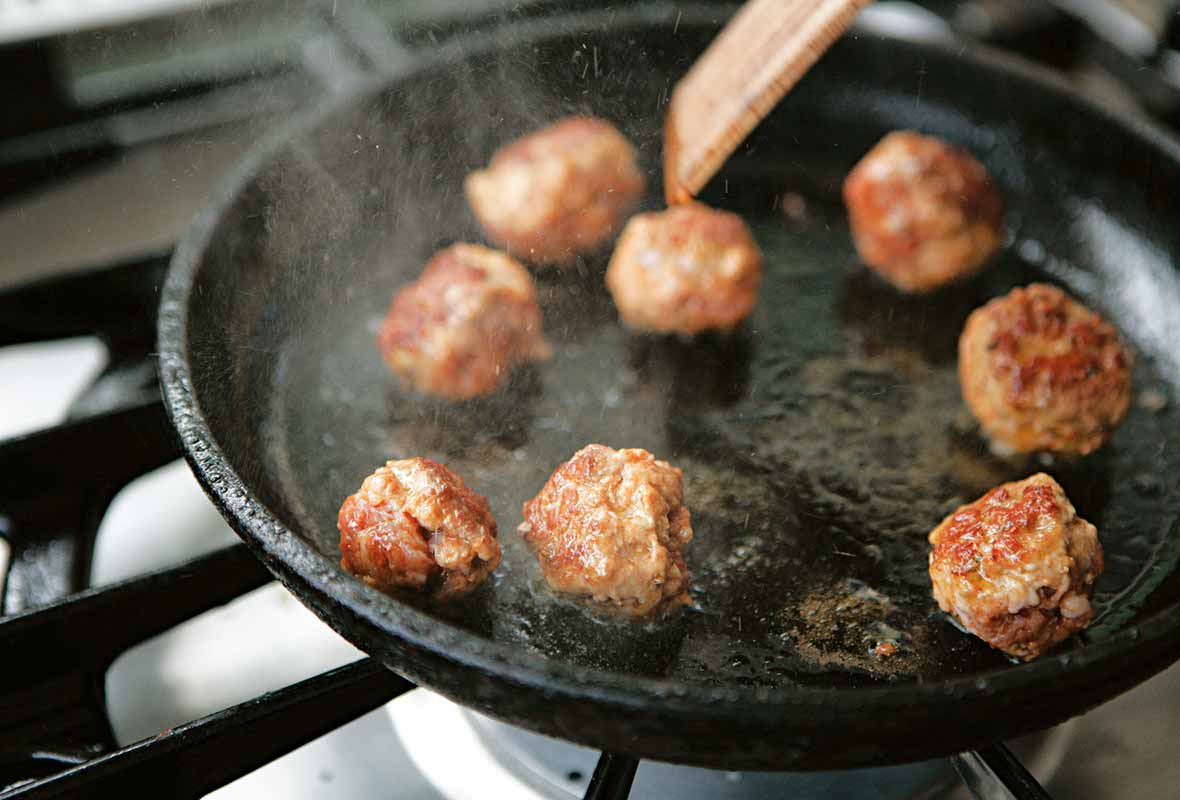
This homemade cheater’s chorizo, an easy riff on real chorizo, is a lovely fresh sausage with a mild heat and a smoky smack that can be quickly mixed up in less than 10 minutes from pork butt, paprika, garlic, cayenne, and the rest of the wine that’s languishing on your countertop. Its keen ability to keep in the fridge for up to a week means you can use it at will, sprinkling it like pixie dust hither and yon, thinking of it more in terms of an Italian sausage than a proper aged chorizo. Whatever you call it, however you use it, we think you’ll be grateful to have a tub of it in the fridge so you can sizzle it up at a moment’s notice.–Renee Schettler Rossi
How To Incorporate Homemade Chorizo Into Your Cooking
Wondering how to use this easy homemade chorizo? Let your imagination be your only limitation. We suggest you turn to the good folks at River Cottage for their advice, which includes “You can shape some into mini meatballs or little patties and fry until browned, then chuck into tomato sauces, bean casseroles, vegetables soups, and the like. Or you can fry a couple of handfuls of the mixture, breaking it up with the edge of a wooden spatula as you go until you have a pan of coarse, crisp chorizo crumbs to scatter over salads, soups, and egg dishes—especially scrambled eggs—or toss with pasta or vegetables, such as broccoli.” Let us know your favorite destination for this cheater’s chorizo recipe by leaving a comment below!

Cheater’s Chorizo
Ingredients
- 1 1/2 pounds pork shoulder or butt, coarsely ground
- 1 tablespoon sweet smoked paprika
- 2 teaspoons hot smoked paprika
- 2 garlic cloves, finely chopped
- 2 teaspoons fine sea salt
- 1 to 11/2 teaspoons fennel seeds
- 1/4 teaspoon cayenne pepper
- 1/4 cup red wine
- Freshly ground black pepper
- A little canola or olive oil, for frying
Instructions
- Place all of the ingredients except the oil in a bowl and squish the mixture between your fingers to evenly distribute everything.
- Heat a little oil in a skillet over medium to medium-high heat. Shape a teensy amount of the sausage mixture into a flattened ball and fry it until cooked through. Taste to check the seasoning, remembering that the flavors will continue to get more noticeable the longer the uncooked mixture stays in the fridge (If you’re a heat fiend, you'll probably want to add more cayenne and black pepper.)
- That’s it. Just cover the chorizo mixture and stash it in the fridge for at least 2 hours before using to allow the flavors time to develop. (The chorizo will keep, refrigerated, for up to 1 week.)
- When ready to use, follow a recipe that calls for fresh chorizo or shape it into small balls and fry over medium to medium-high heat until cooked through.
Notes
How This Homemade Cheater’s Chorizo Differs From Portuguese Chouriço
We want to be clear about one thing. This is not Portuguese chouriço, a smoked sausage traditionally fashioned from pork butt, paprika, garlic, crushed dried red pepper, and a splash of homemade wine in a three-day celebration that takes place twice a year (although if we had our way, it would happen each week!).
Explore More with AI
Nutrition
Nutrition information is automatically calculated, so should only be used as an approximation.
Recipe Testers’ Reviews
You’ll not be disappointed with this homemade chorizo recipe. It’s very good, easy to mix up, and perfect for when you have that little bit of red wine leftover. I did a chile grind over the pork and it worked great.
I wasn’t sure what to expect, but the combination of red spices and the fat from the pork made it look just like store-bought chorizo. Next time, I’ll make it into link sausage. The garlic cloves I used measured out to 2 teaspoons finely minced garlic. It makes a very nice breakfast burrito when mixed with eggs and potatoes.
This is an absolutely simple way to have homemade fresh chorizo right at home—and it tastes much better than the readymade stuff I find in the local supermarket.
I’ll be making this more often to freeze for later use. I’d actually like to make meatballs out of them, too. Also for our taste, I’ll add a tad more cayenne pepper next time. After making it, I decided to stuff squid with it, and it came out spectacular.
This is a wonderful recipe. When I think of fresh chorizo, I always think of Mexican chorizo. Looking at the spices in this recipe, it didn’t seem as though it was going to be that style of sausage, but I wanted to try it anyway. I’m so happy that I did. I think that the flavors are more like the Spanish chorizo, which is usually a cured sausage. The flavors were just like the chorizo that we buy that is imported from Spain. This however, was far superior. There were no chunks of fat that were difficult to chew. Everything here blended into a wonderful burst of flavor.
I questioned leaving the fennel seeds whole—when we make sausage, we usually grind the fennel seeds with a mortar and pestle. I wanted to experiment, so I ended up dividing the pork, which we had ground ourselves, into two bowls. I divided everything else between the two bowls, and put whole fennel seeds in one batch, and the crushed fennel seeds in the other. I cooked up a bit of each in a cast iron pan, and was surprised to find that we liked the whole fennel seed sausage better. We had picked up smoked paprika at The Spanish Table over in Berkeley. The owner of the store, who is very knowledgeable and fun to talk to, had mentioned that he buys the sweet smoked paprika and just adds cayenne when he needs the hot smoked paprika. He said that he gets better control over the finished product and so that’s what I did. I used the sweet smoked paprika and just added cayenne to taste.
I’m really looking forward to using this sausage. I have so many things that I want to do with it. Tomorrow, it’s going into a batch of white beans that I made in a provençal style. I want to use it in soup. I want to use it with pasta. I want to have it with eggs. The possibilities are endless. This will be a recipe that we will make again, and again, and again. I am so very glad that it crossed my path.












Small cooked pieces as a pizza topping instead of pepperoni come to mind. Now without a grinder (should have kept my mother’s clamp on one but perhaps not great for stone counters). I will have to ask the Whole Foods guy to do it. I have a feeling though that they reserve their meat grinder for beef. Anyone tried grinding the pork in a food processor? It would probably clump a bit.
Barbara, that’s a great idea re: the pizza. As far as the grinding meat in a food processor, it’s possible, but you have to be mindful. Hope this helps.
Can I substitute cranberry juice or red wine vinegar for the wine in this recipe, as we can’t afford wine nor can we drink it anyway.
Monica, we haven’t tested it with anything other than wine so I can’t say for certain but it seems as though red wine vinegar should work just fine. Maybe start with just a little and then add incrementally as needed? We’re thinking maybe 3 tablespoons or so? To test for flavor, simply pinch off a tiny amount of the chorizo mixture and fry it in a skillet until cooked through so you can sample it—sorta like making the world’s tiniest meatball!
Do you just add the fennel seeds whole? If not, how do I crush or chop them? I’ve used them with a roast before, where they’d cook for hours, but not in a quick-cook like this. Thank you.
Hi Michele, you can use them whole or if you prefer you could crush them with a mortar and pestle.